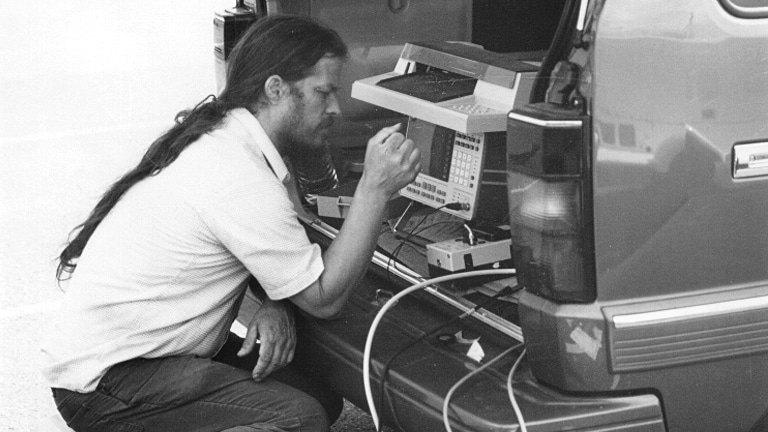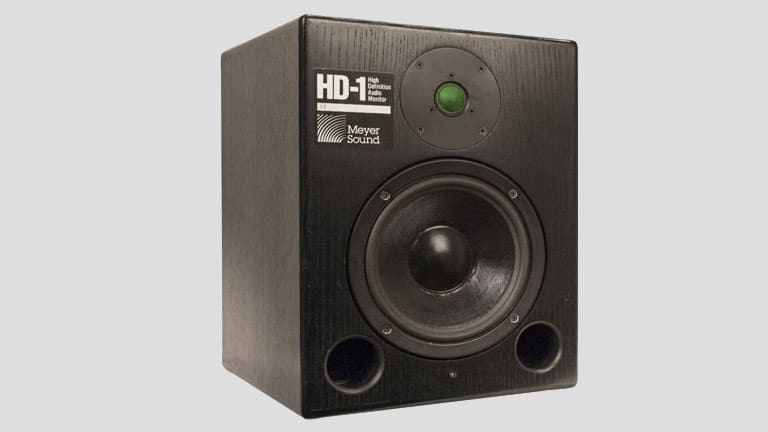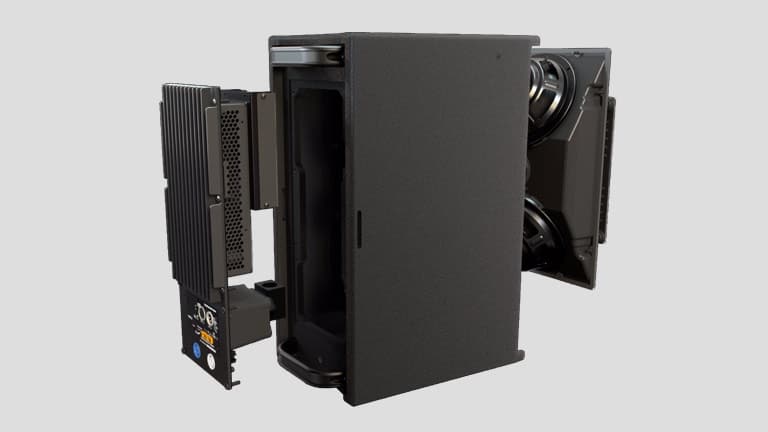| Part Number | 40.220.039.01 |
| Self-Weight | 138 lbs / 62.6 kg |

Think extremely low. With a range of 13-30 Hz—the lowest reach of any Meyer Sound speaker—the VLFC extends below the threshold of human hearing to let your audience feel the sound like never before.
The VLFC’s dual low resonant frequency 18-inch cone drivers produce concussive sonic waves that will take your audience’s breath away. Add the VLFC wherever you need maximum audio intensity—from stadiums to cinemas to theme parks.
The VLFC’s 2-channel Class AB/H bridged amp with complementary MOSFET output stages delivers high continuous and peak power for uncompromising linearity and tight transients at extreme operating levels, with minimal distortion.
Bring It Down An OctaveIt’s easy to add subsonic impact to your system: The VLFC is optimized to pair perfectly with Meyer Sound’s 1100-LFC and other subwoofers to extend low end below 20 Hz. | You’re In ControlVersatile rigging options let you configure the VLFC in ground stacks, flown arrays, or used in an end fired cardioid array. Monitor speaker performance with Meyer Sound’s RMS remote monitoring system. | Security DetailThe VLFC can be flown from an MTG-1100 top grid, which supports arrays of up to 14 cabinets at a 5:1 safety factor. And an optional caster frame anchors stacks of up to three units for secure transport. | Rugged ReliabilityIf you can dish it out, the VLFC can take it, thanks to road-tested features like a brawny multi-ply hardwood cabinet, hex-stamped steel grille, and optional weatherproofing protection. |
Bring It Down An OctaveIt’s easy to add subsonic impact to your system: The VLFC is optimized to pair perfectly with Meyer Sound’s 1100-LFC and other subwoofers to extend low end below 20 Hz. | |
You’re In ControlVersatile rigging options let you configure the VLFC in ground stacks, flown arrays, or used in an end fired cardioid array. Monitor speaker performance with Meyer Sound’s RMS remote monitoring system. | |
Security DetailThe VLFC can be flown from an MTG-1100 top grid, which supports arrays of up to 14 cabinets at a 5:1 safety factor. And an optional caster frame anchors stacks of up to three units for secure transport. | |
Rugged ReliabilityIf you can dish it out, the VLFC can take it, thanks to road-tested features like a brawny multi-ply hardwood cabinet, hex-stamped steel grille, and optional weatherproofing protection. |

We use the VLFCs as a special effect to create a realistic experience of an explosion, one that you feel in your chest more than you hear with your ears. It moves a lot of air; you can definitely feel it.”
“Big Mick” HughesFOH engineer, Metallica
We developed the first versions of the VLFC for NASA to use in vibration testing, but we decided to continue development for uses in both cinema and concert applications. We have done extensive double-blind testing here in our own Pearson Theatre. There’s no doubt that people have a different psychological response when we add in or remove that extra octave from 15 to 30 Hz.”
John MeyerPresident & CEO, Meyer Sound
Meyer Sound has been pioneering self-powered loudspeakers for professional installations and touring since 1995. We’ve committed to self-powered systems because we know they deliver unrivaled clarity, reliable performance, value, and ease of use.
If you’ve been thinking about investing in a self-powered system, you’ve come to the right place.

The story of self-powered loudspeakers is in many ways the story of Meyer Sound itself.
In the 1970s, sound reinforcement technology was inconsistent science at best, and at worst, led to show-ending failures. A young John Meyer, designing loudspeakers for San Francisco’s McCune Sound Service, wanted to bring quality and reliability to sound systems, and he knew the answer lay in self-powered loudspeakers. In 1979 Meyer founded his own speaker company; early Meyer Sound innovations include the iconic HD-1 self-powered studio monitor launched in 1989.
Today Meyer Sound offers a full range of self-powered sound reinforcement products. Meyer Sound systems can be found on tour with artists ranging from Ed Sheeran to Metallica, on Broadway and London’s West End, and in performance venues from the San Francisco Opera to the Vienna Philharmonic not to mention sports stadiums, cruise ships, and houses of worship around the world.

Self-powered loudspeakers offer several advantages over their passive counterparts when it comes to fidelity, reliability, and simplicity. The great part is, you’ll start to reap the benefits of a self-powered system before you even power up.
Ease of deployment: System set-up is so much easier when you have fewer components and fewer cables to worry about being miswired. Since self-powered loudspeakers incorporate amplification, you’ll never have to deal with matching speakers to amplifiers or connecting components. You don’t have to worry about calibration of gain and crossover setting which means more time focusing on the show. Eliminating amp racks doesn’t just streamline system deployment, it streamlines your inventory whether you’re a rental house or a road warrior. And when you consider that the average amp rack weighs nearly 300 pounds and takes up four feet of truck space, the efficiencies get even clearer. Let alone when you want to fly the amplifier racks to get closer to the speakers, often requiring more rigging points and more motors.
Predictable, reliable operation: Internal amplification is closely matched to drivers. Because individual components have been optimized during manufacturing, you can expect consistent sound from show to show. Built-in, factory-optimized protection circuitry provides extra assurance without degrading signal quality. And, when you have less equipment, you have less risk of failure.

Better frequency and phase response: Because self-powered loudspeakers incorporate sophisticated processing, they are calibrated to exhibit optimal response curves in key performance parameters. Active crossovers are more precise, sophisticated designs, and bi-amped systems are time aligned, eliminating phase issues. The result? Accurate sound throughout the speaker’s range, at any volume level.
Unparalleled clarity: In powered monitors, internal amplifiers are precision-matched to drivers, delivering optimal power at all times for cleaner sound. And because amps are built into loudspeaker cabinets, there’s no need for long lengths of connecting cable, which can become prone to distortion and signal loss.
Tighter transients: Since self-powered loudspeakers have very short internal cables, amps inside can more effectively dampen driver mechanical motion, which leads to better sonic accuracy and tighter, crisper transients. (And, there’s none of the loss in levels and signal quality inherent over long cable distances.)
Certified Safe: Nothing matters more than the safety of your staff and customers. Because self-powered loudspeakers incorporate amplification, they must undergo rigorous testing by Underwriters Laboratories and other international organizations to ensure they operate safely and guard against the risk of fire, electric shock, and inadequate structural design. Enjoy peace of mind knowing Meyer Sound powered products are certified by FCC, UL, CSA, CE, and CEE the most stringent agencies in the business.
What about passive loudspeakers? At first glance, passive systems may seem like a bargain. But we already know that passive systems require more components and accessories than powered systems. Sonically, they exhibit potential for signal loss over distances, and it is very hard to ensure consistent, optimal sound and volume as amplifiers have many variables to consider when being matched to loudspeakers, such as cable lengths and gauge as well as the number of speakers connected to the amplifier.
Passive systems are often touted as easy to service. But because powered loudspeakers are so complex to design and build, self-powered loudspeakers usually represent the top innovations from leading manufacturers. Better quality translates to better reliability, which means fewer maintenance issues in the long run.
At face value, passive systems might seem less expensive and easier to maintain. But once you start adding in amps, cables, and other components not to mention increased transport and labor costs you’ll find that those savings just don’t add up to a better value.
Once you recognize all of the advantages inherent in self-powered loudspeaker systems, it’s easy to understand why the world’s top venues and productions rely on them to deliver consistently stunning sound.

| Part Number | 79.240.065.02 |

| Part Number | 79.240.065.03 |